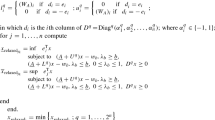Abstract
Interval constraints can be used to solve problems in numerical analysis. In this paper we show that one can improve the performance of such an interval constraint program by the declarative use of constraints that are redundant in the sense of not needed to define the problem. The first example shows that computation of an unstable recurrence relation can be improved. The second example concerns a solver of nonlinear equations. It shows that, by adding as redundant constraints instances of Taylor's theorem, one can obtain convergence that appears to be quadratic.
Similar content being viewed by others
References
Alefeld, G., & Herzberger, J. (1983). Introduction to Interval Computations. Academic Press.
Beldiceanu, N., & Contejean, E. (1994). Introducing global constraints in CHIP. Mathematical and Computer Modelling, 20:97–123.
Benhamou, F., McAllester, D., & Van Hentenryck, P. (1994). CLP(Intervals) revisited. In Logic Programming: Proc. 1994 International Symposium, 124–138.
Benhamou, F., Bouvier, P., Colmerauer, A., Garetta, H., Giletta, B., Massat, J-L., Narboni, G. A., N'Dong, S., Pasero, R., Pique, J-F., Touraïvane, Van Caneghem, M., & Vétillard, E. (1996). Le manuel de Prolog IV. Technical report, PrologIA, Parc Technologique de Luminy, Marseille, France.
Benhamou, F., & Older, W. J. (1997). Applying interval arithmetic to real, integer, and Boolean constraints. Journal of Logic Programming, 32:1–24.
BNR. (1988). BNR Prolog user guide and reference manual.
Bol, R., & Degerstedt, L. (1993). Tabulated resolution for well-founded semantics. In Proc. of the Symposium on Logic Programming.
Chen, W., & Warren, D. S. (1996). Tabled evaluation with delaying for general logic programs. Journal of the ACM, 43(1):20–74.
Cheng, B. M. W., Lee, J. H. M., & Wu, J. C. K. (1996). Speeding up constraint propagation by redundant modelling. In Lecture Notes in Computer Science, volume 1118, pages 91–103. Springer-Verlag.
Cleary, J. G. (1987). Logical arithmetic. Future Computing Systems, 2:125–149.
Coolidge, A. S. (1932). A quantum mechanics treatment of the water molecule. Physical Review, 42:189–209.
Hansen, E. (1992). Global Optimization Using Interval Analysis. Marcel Dekker.
Van Hentenryck, P. (1989). Constraint Satisfaction in Logic Programming. MIT Press.
Van Hentenryck, P., Michel, L., & Deville, Y. (1997). Numerica: A Modeling Language for Global Optimization. MIT Press.
Hille, E. (1964). Analysis, Volume I. Blaisdell.
Mackworth, A. K. (1977). Consistency in networks of relations. Artificial Intelligence, 8:99–118.
Michie, D. (1968). Memo functions and machine learning. Nature, 218:19–22.
Montanari, U. (1974). Networks of constraints: Fundamental properties and applications to picture processing. Information Science, 7(2):95–132.
Montanari, U., & Rossi, F. (1991). Constraint relaxation may be perfect. Artificial Intelligence, 48:143–170.
Moore, R. E. (1966). Interval Analysis. Prentice-Hall.
Neumaier, A. (1990). Interval Methods for Systems of Equations. Cambridge University Press.
Older, W. (1992). Constraints in BNR Prolog.
Older, W. J. (1993). Using interval arithmetic for non-linear constrained optimization. Bell-Northern Research Technical Report.
Older, W. J. (1989). The application of relation arithmetic to X-ray diffraction crystallography. Bell-Northern Research Technical Report.
Older, W. J., Swinkels, G. M., & van Emden, M. H. (1995). Getting to the real problem: Experience with BNR Prolog in OR. In Leon Sterling, editor, Proceedings of the Third International Conference on the Practical Application of Prolog, pages 465–478. Alinmead Software Ltd.
Press, W. H., Teukolsky, S. A., Vetterling, W. T., & Flannery, B. P. (1992). Numerical Recipes in C, Second Edition. Cambridge University Press.
Sagonas, K., Swift, T., & Warren, D. S. (1994). XSB as an efficient deductive database engine. In Proc. of SIGMOD 1994 Conference. ACM.
Semenov, A. L. (1996). Solving optimization problems with help of the Unicalc solver. In R. Baker Kearfott and Vladik Kreinovich, editors, Application of Interval Computations, pages 211–224. Kluwer Academic Publishers.
Tamaki, H., & Sato, T. (1986). OLDT resolution with tabulation. In Third International Conference on Logic Programming, 84–98.
van Emden, M. H. Finding nonzeroes of nonlinear functions. In preparation.
van Emden, M. H. (1997). Value constraints in the CLP Scheme. Constraints, 2:163–183.
Waltz, D. (1975). Understanding line drawings in scenes with shadows. In Patrick Henry Winston, editor, The Psychology of Computer Vision, pages 19–91. McGraw-Hill.
Zhou, J. (1997). Calcul de plus petits produits cart´esiens d'intervalles. Ph.D. thesis, Laboratoire d'Informatique de Marseille.
Author information
Authors and Affiliations
Rights and permissions
About this article
Cite this article
van Emden, M.H. Algorithmic Power from Declarative Use of Redundant Constraints. Constraints 4, 363–381 (1999). https://doi.org/10.1023/A:1009821007410
Issue Date:
DOI: https://doi.org/10.1023/A:1009821007410




